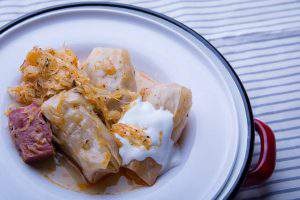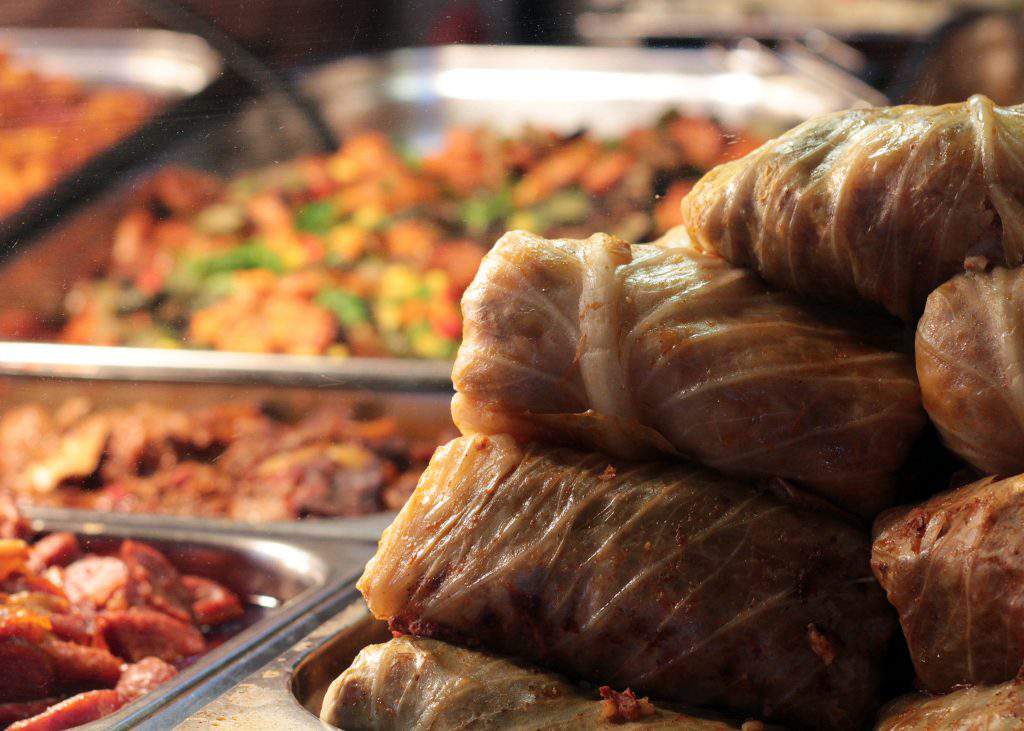Recipe of the week: Stuffed cabbage

It is the splendour of the Christmas table, it is the taste of grandma’s love and it is the indispensable part of the festivity – it is the stuffed cabbage. This hearty meal is the essential part of the Hungarian cuisine, which you must try when in Hungary 🙂
“…and then came the stuffed cabbage.” According to origo.hu, this is how the dish is frequently mentioned. It is usually followed by a deep sigh or moan. The sentence is usually said at the time of festivities, after Christmas Eve or a wedding night when recalling the menu. This part of the sentence has several meanings. First of all, we’d like to express how much we love stuffed cabbage and that we wouldn’t miss it for a thing. But it also means distress, because we tend to believe that if we miss the festivities without eating stuffed cabbage, we’ll be the victims of some kind of curse.
Stuffed cabbage plays an important but somehow secondary role in the festive menu: it always comes when we’re already full with the other delicacies. And we’re also afraid that we won’t be able to fit it onto our stomach. So we sigh. At weddings, it is served in the middle of the night when you’ve already eaten six courses, but you feel like you need to refuel so that you can keep on drinking and dancing.
This secondary role is especially interesting considering that it is such a hearty meal that a plate of stuffed cabbage can fill you up for the whole day. And you can’t make a small portion, it is usually made in a big batch. This is why stuffed cabbage is a beloved leftover from the Christmas menu.

According to the ethnographic lexicon, it is a meal of Turkish origin, which was originally a rice-meat filling stuffed in vine-leaves. It is an old recipe, because it is already mentioned in the oldest Hungarian cookbooks.
The ancestor of the stuffed cabbage was cabbage-meat in the Hungarian cuisine. The dish spread in the Balkans and Hungary in the 17h-18th century. The Szakácsmesterségek cookbook from 1695 featured two versions. One of them was the cabbage from Kolozsvár (Cluj-Napoca) which called for goose or hen meat, while the other stuffed cabbage recipe called for “cow meat” and ginger.
The recipe of stuffed cabbage went through a lot of changes throughout history, and it still remains one of those meals with plenty of variations. Every family makes it differently, with different secret ingredients. Opinions also differ on the most important steps and ingredients. Is the meat the most important part? Is it the dumpling? Or is it the cabbage? Do you have to precook the rice, do you need eggs and do you need to stir it?

It would be impossible to reach consensus in these questions and to find an ultimate or best recipe. We picked one we liked, but it is quite probable that your neighbour, mother, grandma does something differently. Nonetheless, we hope you enjoy 🙂
Ingredients:
- 5 kg of sauerkraut
- 12 cabbage leaves (sour as well)
- 400 grams of pork scapula
- 400 grams of pork leg
- 400 grams of smoked side ribs
- 100 grams of sausage
- 200 grams of lard
- 1 onion
- 120 grams of rice
- 3 cloves of garlic
- tablespoon of paprika
- 4 bay leaves
- salt, pepper
- tablespoon of pork fat
- tablespoon of flour
- 50 ml of water
Directions:
If you’re using trusty, homemade smoked side ribs, let it soak in water for a day. (Most meat made with the quick smoking technique only need a solid wash.) You need to cook it for one-one and a half hours until it becomes medium soft. Cook the rice halfway and let it cool down. Rinse the sauerkraut and put it aside.
Chop up the onion and the lard. Cook the lard until it releases fat and roasts a bit. Take the greaves out and fry the onion in the fat. Add the ground pork scapula and leg into a bowl along with the half-cooked rice, onion, greaves, crushed garlic, a teaspoon of pepper, two teaspoons of salt and a tablespoon of paprika. Add 50 ml of water and mix it all together (water replaces eggs, because eggs would harden the filling).
Separate the filling into 12 equal pieces. Take a look at the cabbage leaves: if they have a hard stump, cut it out because you need them to be soft so that they can be rolled up. Take a leaf into your hand in a way that the stump is facing upwards. Put one portion of filling in the middle and fold in the leaves. Start from above, then from under and lastly from the left. After the last fold, roll it up it up to the right. This way your fillings will be secure enough.

Take a huge pot and line it with part of the sauerkraut. Add a few fillings, some pieces of sausage and smoked side ribs. Then comes the second layer of sauerkraut, and another layer of filling, sausage and side rib pieces. Continue this until you run out of ingredients. It is essentially up to you how many layers you’d like to have. Just make sure that you finish with sauerkraut on the top. Add a few bay leaves on the very top and pour in as much of the side ribs’ cooking water as is enough to cover the dish.
Cook it over medium heat for around two hours. When it’s done, let it cool for a bit. Then carefully take out the fillings. Melt the fat, add some paprika and flour. Slowly pour in water while constantly mixing until it reaches the consistency of sour cream. Add it to the cooked sauerkraut to thicken it. When serving, start with the sauerkraut on the bottom, add the filling, side ribs, and sausages on the top. You can make it even tastier with some sour cream and homemade bread.
Enjoy your meal!
Featured image: GLOBS Magazine
ce: bm
Source: Daily News Hungary






This is exactly the way my mother made them right down to the fat, paprika and flour to thicken.